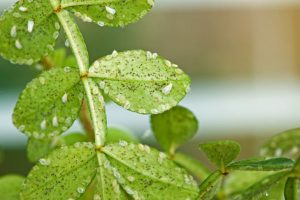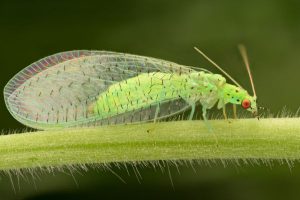
As we round into June, the pest season heats up. Insects, being cold blooded, respond to the warming temperatures by growing rapidly through their life cycles.
Whiteflies are a good example of this. These small pests take about 24 days to go through their immature stages and can live (and reproduce) for 30-40 days. During their adulthood they can lay up to 400 eggs! (eek!). They are very indiscriminate eaters and attack many different kinds of landscape and edible plants.
One variant of the whitefly, the Silver Whitefly has become pesticide resistant. And while they fly around, pushing their mouthpieces into our plants to pull out sap, they spread diseases. This makes them a major enemy of commercial growers and homeowners alike.
Identification
You can usually identify whiteflies by the adult reaction to your approach. As you walk up, the adults tend to fly up, creating a small flying white cloud. It makes identification of the problem fairly easy. The immature insects and eggs can also be found on the underside of the leaves along the veins of the leaf. They are not as mobile as the adults and less able to get away.

If you have whiteflies, it will usually appear as leaves shriveling up, turning pale or yellow and falling off. The damage is happening as the insects suck out the sap from the leaf. They also secrete a sugary substance that will encourage the growth of mold called sooty mold so leaves underneath may turn dark gray or blackish. This will weather off after the whiteflies are gone.
Treatment
Some of the larval stages have a waxy coating which makes pesticide use a little less effective. Oils like neem oil and all-season horticultural oil will help to smother the more vulnerable stages, but the current high temperatures cause another problem: foliage burn. The oil on the leaves can cause some plants to more wilt, they will burn. So, while you might be smothering the pest, you are damaging the plant which is not a good trade. If the infestation is severe, you may want to clip off a leaf or two. Tossing the pests prevents them from maturing.

Natural Predators
One good possibility is to use natural predators. Lacewing larvae, parasitic wasps, and ladybugs all can get by the waxy coating and consume the insects, solving the problem without damaging the plant or poisoning your environment. Arbico is one mail order source for beneficial insects.
Remember that when they have gobbled up the insects, they will move on to find a new source of food. It is possible to cultivate beneficial insects by the way you garden.
——-
This article was written by master gardener, Becky Wern. For more information on the Master Gardener program or to schedule a yard visit to see how you can deploy Florida Friendly Pest Management practices, please click the blue lettering links.
 0
0
